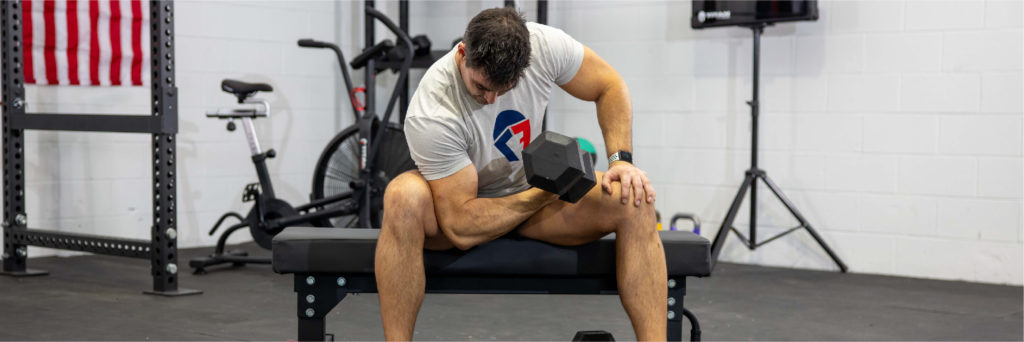
If you want to start lifting weights, but don’t know which to buy, what size, or which kind, then this article is for you. We’re going to get you right on track when it comes to introducing weights into your workouts. Dumbbells, kettlebells, and barbells are great pieces of equipment that will elevate your fitness routine to the next level.
Guide to Buying Dumbbells for Beginners
Dumbbells are a great introduction to lifting weights because they’re easy to use, are extremely versatile, and last a lifetime. There are 3 common types of dumbbells; rubber coated hex, neoprene, and adjustable. Here’s a brief breakdown of each:
Rubber Coated Hex Dumbbells: Ranging from 5 lbs to 50 lbs with easy-to-grip handles and black, shock-absorbing heads on either side, these particular dumbbells are perhaps the best weight sizes for beginners.
Neoprene Dumbbells: Usually Ranging from 5 lbs to 10 lbs with finger friendly handling, these dumbbells are a great option for those looking to incorporate an aerobic component to their weight training. And let’s be honest, the colorful neoprene coating makes them almost impossible to lose!
Adjustable Dumbbells: Ranging from 5 lbs to 100 lbs with the flexibility to tweak your training in a jiffy, these dumbbells will lift you to your desired fitness results: whether that be as a novice lifter, or an Olympic level athlete.
We recommend starting anywhere between 5 lbs and 20 lbs and then slowly increasing weight each week. Here’s an example:
Dumbbell Bench Press: Week 1-3×8 at 20 lbs / Week 2-3×10 at 20 lbs / Week 3-3×8 at 25 lbs / Week 4-3×10 at 25 lbs
How to Buy the Right Kettlebell
While dumbbells are great for sculpting muscle and building strength, they may not be the best option for endurance training. Enter the kettlebell.
Cast Iron Kettlebells: No nonsense. No bells and whistles. Just a tool that works and is as durable as the day is long. Cast iron kettlebells are a solid piece of metal, with a wide handle, allowing you to use two hands if necessary.
Competition: If you’re looking to compete in a CrossFit competition in the future, then look no further. The competition kettlebell has a more square design. The handle is smaller than a cast iron kettlebell, designed to be used with just one hand. Ranging from 18 lbs to 88 lbs, these kettlebells will build your body into a WOD machine!
Adjustable: If you’re low on space but high on motivation, then outfitting your gym with Adjustable kettlebells is a no-brainer These kettlebells allow you to have the luxury of owning varying weights, all in one kettlebell. They also allow you to stack or strip weight under the handle to meet you where you’re at.
We recommend starting anywhere between 18 lbs to 35 lbs and then slowly increasing weight each week. Here’s an example:
Kettlebell swings: Week 1-3×12 at 26 lbs / Week 2-3×15 at 26 lbs / Week 3-3×12 at 35 lbs / Week 4-3×15 at 35 lbs
What are the Best Barbells for Beginners
For the uninformed, barbells are well, bars, that allow you to load more weight onto them than you would for a dumbbell, or kettlebell. But, they’re great on their own without weight, too. By increasing your reps, you can still gain that muscle you’re aiming towards.
Olympic Barbells: Our Olympic barbells are multi-functional and can accommodate those looking to make some serious gains this year, or those looking to be more functionally fit.
Specialty Bars: Barbells are kinda like eggs: we’ve all had eggs, but there’s always new ways to make eggs. Each specialty bar provides a new way to make gains.
Fixed Weight: Ranging from 20 lbs to 110 lbs, what you see is what you get with Fixed Weight Barbells. Nothin’ fancy. Just work.
We recommend starting anywhere between 45 lbs and 95 lbs and then slowly increasing weight each week. Here’s an example:
Barbell Complex: Week 1-3×10 with barbell / Week 2-3×12 with barbell / Week 3-3×15 with barbell / Week 4-3×20 with barbell
Deadlifts: Week 1-3×5 at 95 lbs / Week 2-3×5 at 100 lbs / Week 3-3×5 at 105 lbs / Week 4-3×5 at 110 lbsSo, now that you know which size weights to buy as well as which kinds, doesn’t it make sense to invest in the only body you’ve got and get some actual weight in your home gym?


